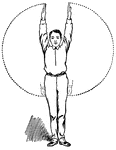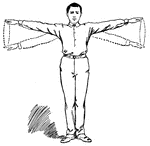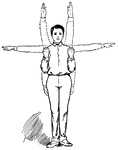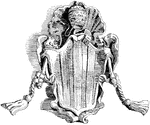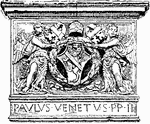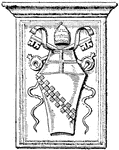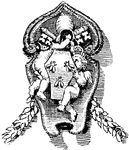
Octopus
"The Octopus is the typical genus of the family Octopodidæ. The body is oval, warty, or cirrose,…

Orang Outang
"The Orang Outang is the Mias of the Dyaks; also known as the 'wild man of the wood.' It is a dull,…

Demosthenes
"In the oratory of more thn two thousand years Demosthenes stands in the front rank, and will always…

Julian
"Thus the prince, both when present and when coming, was alike victorius: and these things he achieved…

Arma
"Homer describes in various passages an entire suit of armour, and we observe that it consisted of the…

Arma
"Homer describes in various passages an entire suit of armour, and we observe that it consisted of the…
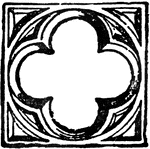
Quatrefoil
"The quatrefoil is four-leaved grass; a frequent bearing in coat-armor."—(Charles Leonard-Stuart,…

Procyon Lotor Raccoon
"The Raccoon, or Racoon, is a handsome animal, about the size of a large cat, brown furry hair, tail…
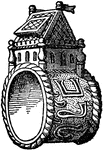
Ring
"A Ring is any circle or section of a cylinder. Rings of gold, silver, and of other metals and materials…

Ring
"A Ring is any circle or section of a cylinder. Rings of gold, silver, and of other metals and materials…
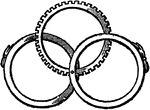
Ring
"A Ring is any circle or section of a cylinder. Rings of gold, silver, and of other metals and materials…
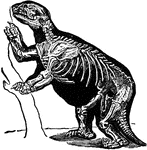
Giant Sloth
"Sloth is the popular name for any individual of the Edentate group Tardigrada, from their slow and…

Spoonbill
"Spoonbill is the popular name of the birds of the genus Platalea, belonging to the heron family (Ardeidæ),…
!["Starfish is a popular name for any individual of the family Asteridæ, a familiar object on the Atlantic coasts. The body is more or less star shaped, and consists of a central portion, or disk, surrounded by five or more lobes, or arms, radiating from the body and containing prolongations of the viscera. The mouth is situated in the center of the lower surface of the body, and the anus is either absent or on the upper surface. Locomotion is effected by means of peculiar tube-like processes, which are protruded from the under surface of the arms. They possess in a high degree the power of reproducing lost members and abound in all seas. [Pictured] Lesser Sand-star (Ophiura albida)"—(Charles Leonard-Stuart, 1911)](https://etc.usf.edu/clipart/16200/16266/starfish1_16266_mth.gif)
Lesser Sand-Star Starfish
"Starfish is a popular name for any individual of the family Asteridæ, a familiar object on the…
!["Starfish is a popular name for any individual of the family Asteridæ, a familiar object on the Atlantic coasts. The body is more or less star shaped, and consists of a central portion, or disk, surrounded by five or more lobes, or arms, radiating from the body and containing prolongations of the viscera. The mouth is situated in the center of the lower surface of the body, and the anus is either absent or on the upper surface. Locomotion is effected by means of peculiar tube-like processes, which are protruded from the under surface of the arms. They possess in a high degree the power of reproducing lost members and abound in all seas. [Pictured]Common Starfish, reproducing rays"—(Charles Leonard-Stuart, 1911)](https://etc.usf.edu/clipart/16200/16277/starfish2_16277_mth.gif)
Common Starfish
"Starfish is a popular name for any individual of the family Asteridæ, a familiar object on the…
!["Starfish is a popular name for any individual of the family Asteridæ, a familiar object on the Atlantic coasts. The body is more or less star shaped, and consists of a central portion, or disk, surrounded by five or more lobes, or arms, radiating from the body and containing prolongations of the viscera. The mouth is situated in the center of the lower surface of the body, and the anus is either absent or on the upper surface. Locomotion is effected by means of peculiar tube-like processes, which are protruded from the under surface of the arms. They possess in a high degree the power of reproducing lost members and abound in all seas. [Pictured]Common Starfish (Asterias rubens)"—(Charles Leonard-Stuart, 1911)](https://etc.usf.edu/clipart/16200/16278/starfish3_16278_mth.gif)
Common Starfish
"Starfish is a popular name for any individual of the family Asteridæ, a familiar object on the…
!["Starfish is a popular name for any individual of the family Asteridæ, a familiar object on the Atlantic coasts. The body is more or less star shaped, and consists of a central portion, or disk, surrounded by five or more lobes, or arms, radiating from the body and containing prolongations of the viscera. The mouth is situated in the center of the lower surface of the body, and the anus is either absent or on the upper surface. Locomotion is effected by means of peculiar tube-like processes, which are protruded from the under surface of the arms. They possess in a high degree the power of reproducing lost members and abound in all seas. [Pictured]Eyed Cribella (Cribella oculata)"—(Charles Leonard-Stuart, 1911)](https://etc.usf.edu/clipart/16200/16280/starfish4_16280_mth.gif)
Eyed Cribella Starfish
"Starfish is a popular name for any individual of the family Asteridæ, a familiar object on the…
!["Starfish is a popular name for any individual of the family Asteridæ, a familiar object on the Atlantic coasts. The body is more or less star shaped, and consists of a central portion, or disk, surrounded by five or more lobes, or arms, radiating from the body and containing prolongations of the viscera. The mouth is situated in the center of the lower surface of the body, and the anus is either absent or on the upper surface. Locomotion is effected by means of peculiar tube-like processes, which are protruded from the under surface of the arms. They possess in a high degree the power of reproducing lost members and abound in all seas. [Pictured]Gibbous Starlet (Asterina gibbosa)"—(Charles Leonard-Stuart, 1911)](https://etc.usf.edu/clipart/16200/16282/starfish5_16282_mth.gif)
Lesser Sand-star Starfish
"Starfish is a popular name for any individual of the family Asteridæ, a familiar object on the…
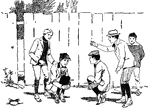
Cock-Fighting
"Two players are made to sit on the ground draw their legs up, and clasp their hands together over their…
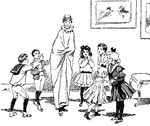
The Giant
"This may be done in two ways: first and most difficult, by one boy standing on another's shoulders,…

Tadpole
"The Tadpole is the larva of the anurous amphibia, sometimes so far extended as to include larvaæ…

Tadpole
"The Tadpole is the larva of the anurous amphibia, sometimes so far extended as to include larvaæ…
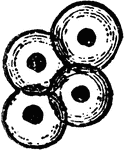
Frog Eggs
"The Tadpole is the larva of the anurous amphibia, sometimes so far extended as to include larvaæ…
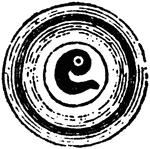
Frog Egg
"The Tadpole is the larva of the anurous amphibia, sometimes so far extended as to include larvaæ…

Chariot
"Arms and a chariot are here assigned to June through not properly a warlike goddess. The idea itself,…
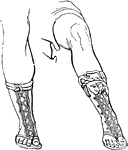
Cothurnus
"The cothurnus or buskin, rose above the midddle of the leg so as to surround the calf (sura),…
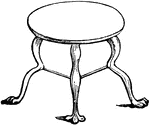
Mensa
"The simplest kind of table was a round one with three legs. It is shown in the drinking scene painted…
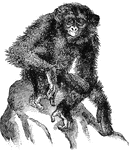
Chimpanzee
A large West African Ape. A dark blackish brown hair, flesh-colored hands and feet, arms reaching to…

Chinchilla
A small south American rodent quadruped of the genus Chinchilla, especially C. lanigera; a pika-squirrel.…

Boxer with cestus
"The cestus was used by boxers from the earliest times. It consisted of thongs of raw ox-hide, or of…

As Skirmishers, Guide Center, March Signal
"Raise both arms laterally until horizontal; swing both simultaneously upward until vertical and return…

As Skirmishers, Guide Right (Left), March Signal
"Raise both arms laterally until horizontal; hold the arm on the side of the guide steadily in the horizontal…
Order Arms Standing
"The butt rests evenly on the ground, barrel to the rear, toe of the butt on a line with toe of, and…
Present Arms
"With the right hand carry the piece in front of the center of the body, barrel to the rear and vertical,…
Port Arms
"With the right hand raise and throw the piece diagonally across the body, grasp it smartly with both…
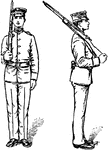
Right Shoulder, Arms
"Without changing the grasp of the right hand, place the piece on the right shoulder, barrel up and…
Left Shoulder, Arms
"Carry the piece with the right hand and place it on the left shoulder, barrel up, trigger guard in…
Trail Arms
"Raise the piece, right arm slightly bent, and incline the muzzle forward so that the barrel makes an…
Inspection Arms
"At the second command take the position of arms. Seize the bolt handle with the thumb and forefinger…
Stack Arms
"Each even number of the front rank grasps his piece with the left hand at the upper band and rests…
